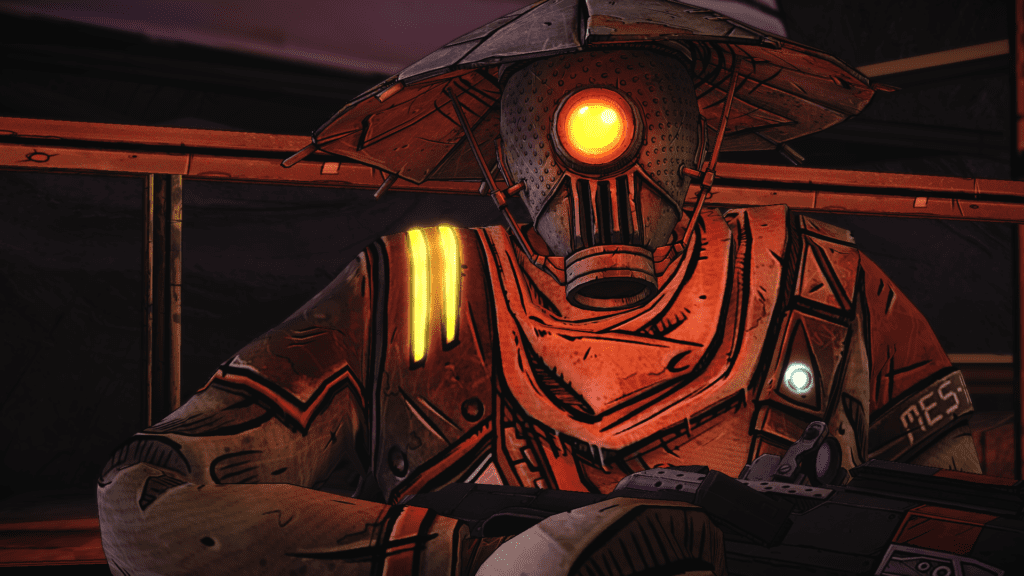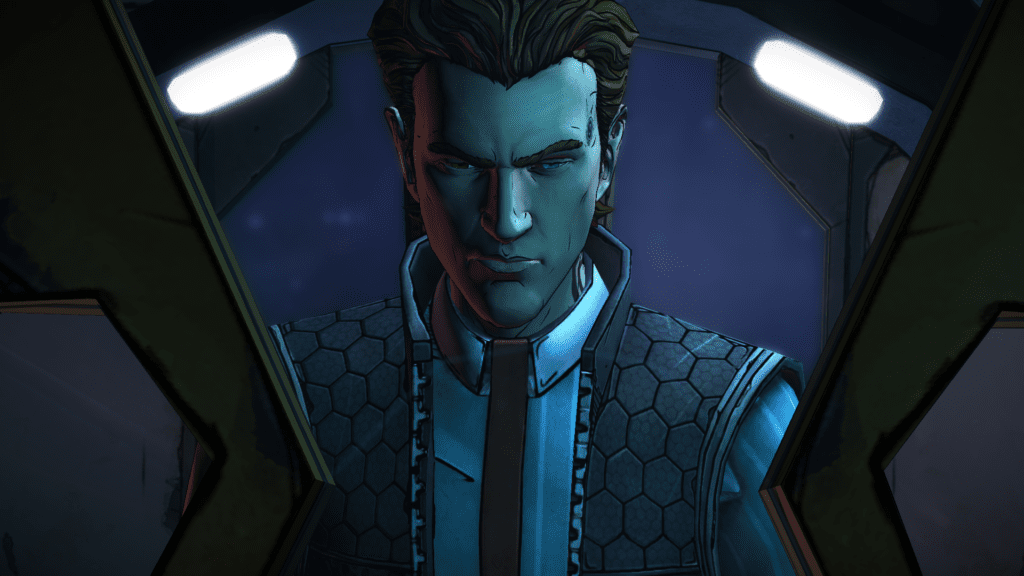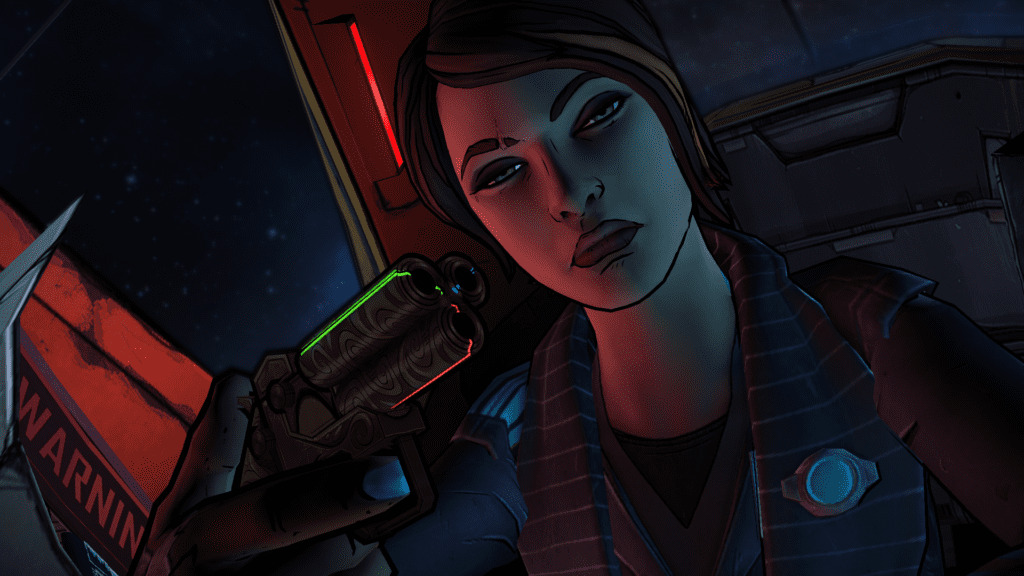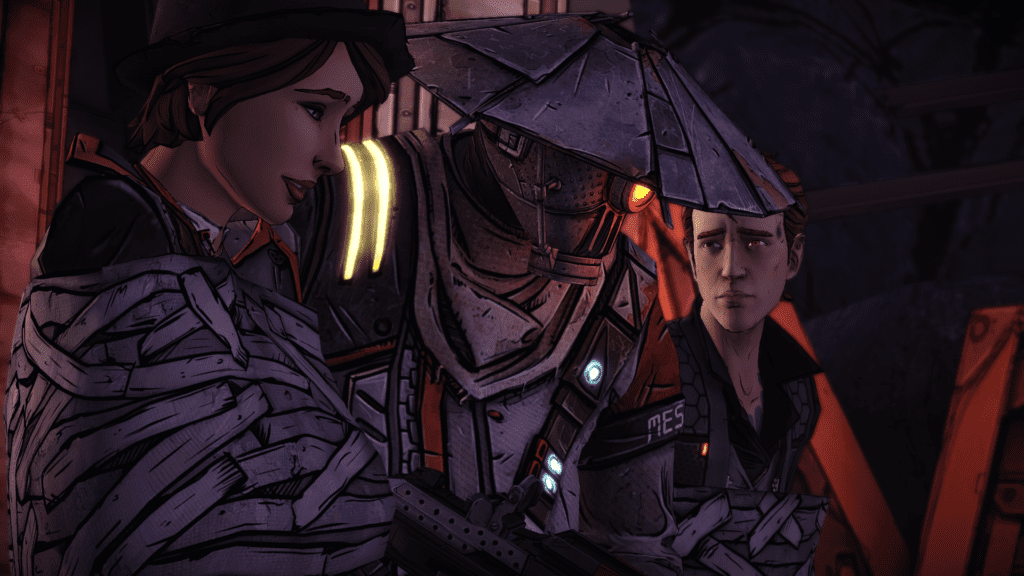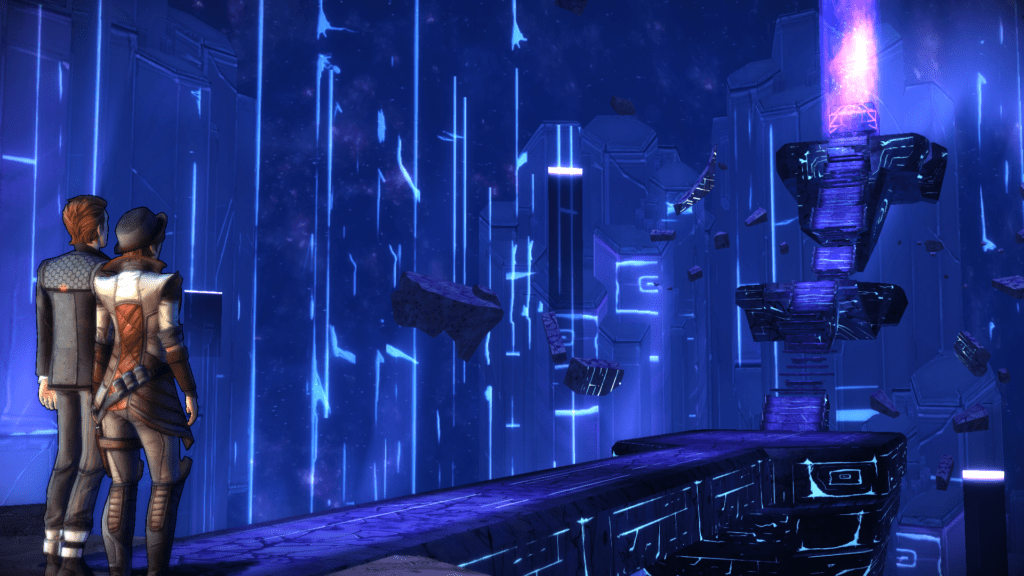The bus, the train and the rocket. Three ways of heading straight into the brutal world of the Borderlands, three vessels that traded a comfortable journey for a shot at unfathomable riches by way of much more fathomable danger. It was the bus that arrived first. Nothing more than rickety metal seats and the gruff drawl of its conductor to deal with as it bounced along the narrow trail en route to the barren township. The train, however, exploded before ever reaching its destination, while the rocket at least made it to its destination before burning to a crisp. For every introduction, there was song that underscored the Borderlands logo as it sat atop the seared Pandoran horizon or hovered in the starry orbit of its lone moon, Elpis. Chiming aloud was ‘Ain’t No Rest For The Wicked’ as Brick cracked his knuckles and Roland palmed off the camera, this as Borderlands first announced itself to the world.
It was the original Borderlands instalment that first caught my interest, its enjoyably simplistic hook keeping me invested in the series for the better part of a decade. And after wrapping up Telltale’s Tales From The Borderlands for the second time in a week, I’m reminded as to why I keep coming back. Though the thin mist of a freshly sealed loot chest slowly revealing its contents definitely has a distinct allure, it’s the world that Gearbox has built beyond the inherent scavenging fixation that keeps me looking ahead to the series’ next title. Another way back into the fray – a boat this time? Another catchy tune ringing out as a seaborne Skag becomes inescapably tethered to an anchor. Another disjointed foursome clinging on for dear life as the thing capsizes. Jack ain’t coming back this time, but his legacy may lie in a successor being even more of an egomaniacal, psychopathic murderer than perhaps he ever was.
Two mainline games, a parallel spin-off and a canonical contemporary later, and the Borderlands brand sits still awaiting the next story to spill forth from the depths of one of its many darkened nooks. The first game in the series introduced us to the general lay of the land: the warmongers, the profiteers, and, above all, the ceaseless quest for power that begins and ends with the acquiring of vault keys and the riches that dwell within the secluded sanctums that they unlock. Four ragtag mercenaries pulled together to slay an ancient beast and its would-be captor, and in doing so, became the closest thing to heroes that Pandora had seen for a very long time. Borderlands 2 meanwhile diverted the immediate spotlight from the vault itself to the insatiable lust espoused by the next maniac in pursuit of one. His name was Handsome Jack, he was the leader of the Hyperion arms corporation, and as evident by the glowing violet scars across Pandora’s surface, the roots of his desire for power seemingly had no end to their reach. It was the Pre-Sequel that would finally detail Jack’s moulding into that of the nefarious reaper sewing moonshots of death and damnation from his cold chambers back on Helios. Jack’s demeanour leant a lot on acts of betrayal brought upon him by those he thought he could trust. His fall was harsh. Pandora’s, even harsher.
The storytelling across this trilogy of Borderlands titles has met with little deviation ever since the original game set its precedent. In the thick of the fray, your steward – be it Claptrap, Tannis or even Jack himself – would crop of via a flickering icon in the corner of the screen and season your shooting with just the right amount of dialogue to not seem cumbersome. Turning in missions brought you to interact with actual characters in the game world – tapping the interact button a few more times even after your business had concluded may have even rewarded you with a few little extra tidbits of discourse.
* * *
And at cornerstone moments within the story, pre-rendered cutscenes afforded players the chance to revel in the fruits of their labour. Bleeding one act into the next, it was here where controllers and keyboards sat dormant as action left the players control and the narrative felt unshackled from the shooting. For as much as the shoot-and-loot cycle is indicative of the essence of Borderlands, the same can be said for the way in which the series conveys a story. And it’s why the only outlier in the series felt that little more departed from what we’ve typically come to expect.
Telltale Games Tales From The Borderlands may have seemed like the usual Telltale fare draped in a Borderlands lacquer, but in the continued absence of Borderlands 3, it had accomplished more for the progression of the series’ branching narrative than perhaps even the Pre-Sequel. But the Pre-Sequel was never in the ideal position to succeed – it filled us in on some interesting elements of the extended story, but did so in a way that seemed all too familiar. The aforementioned structure of storytelling was not something to be drastically altered within a spin-off, and for all of the Pre-Sequel’s problems, the way in which it told its tale was surely not one of them. Tales From The Borderlands however, was different. No shooting, no looting, no class mods or skill trees or ECHO recorders. It was a detraction that boiled away the fat and focused on the most integral aspect of the game that drew many of us to it originally – the alien world, and its alien inhabitants. And by the time that it was all over, Tales From The Borderlands had affirmed one thing in particular – that even when stripped of its thousands of weapons, it still packed a powerful enough punch to deliver the most meaningful Borderlands story yet told.
Before Tales From The Borderlands, it was Borderlands 2 that drew my personal pick for the series’ best story, and a lot of that, naturally, was due to its centrepiece villain. Borderlands 2 had a lighter tone than its predecessor, more humorous and abrasive, even if a lot of its staple humour felt unnaturally forced much of the time. The story of Borderlands 2 felt so gratifying because it paired well with the games inherent linear progression style, taking the player to all corners of Pandora in pursuit of a single horrible spectre. Along your journey Jack goads and jabs at you as you uncover more of his secrets and begin to chip away at his overly confident demeanour. Spending the game clambering across mountains and through deserts whilst waging a psychological war with Jack in which victory rewards only a single stutter in his speech pattern makes for an intense ride. And its what makes the fight with him at the end that little more special, that eventual execution a little more fulfilling.
Traveling throughout Pandora to all of these new locations was made all the more special when stumbling across something entirely recognisable. If your Borderlands journey began with the very first game, then it began with the bus stop at Fyrestone. And to see it in a state of disrepair – well, further disrepair, all courtesy of Jack and the Hyperion corporation – adds that extra shade of malevolence to the man responsible for many of the planet’s woes. Such a horror requires an almighty force to bring him down, and so calling upon the Vault Hunters of the previous Borderlands title to serve as supporting characters to the new ones legitimised both Jack’s strength and the collective force of the Vault Hunter fraternity.
* * *
But even as the once playable Lilith, Mordecai, Brick and Roland became these animated figures on the opposite side of the screen, they felt far more alive than any of the other six Vault Hunters that we as the player had to choose from. The Pre-Sequel introduced more passive dialogue for player characters to make them seem less dormant, but it’s your somewhat absent role within fixed conversations outside of cutscenes that make you feel like a bystander in a story that’s being told around you rather than through you.
It isn’t just Jack and his backstory that warrants exploring. Every Borderlands game sans the Telltale one is littered with ECHO recorders detailed with exposition, with much of it integral to the Vault Hunters at the heart of the story presently being told. But the problem with ECHO recorders is that they don’t offer a fix for the numbing issue of the story orbiting the action. During cut-scenes and conversations – at any point when the gunfire has ceased – there’s clarity, and with clarity comes a necessary moment of pause for the unpacking of one of the game’s key characters. Picking up an ECHO mid-fight will likely drown it out beneath the guttural gargling of blood and mechanical clanking of machinery. ECHO recordings are quick fixes, enjoyable expository patches, but really just a band-aid when it comes to exploring the backstory of the newly introduced player controlled characters. There’s a lot more left unsaid that an ECHO cannot convey, even if its purpose is fulfilled by way of dictating lore outside of the main plot.
Tales From The Borderlands however has the distinct advantage of dialogue as its weapon of choice. And with pacing dictated primarily by the plot rather than the player, its foundation: the characters, the branching narrative, the very world of the Borderlands, is never unearthed by a sudden misdirection. Everything – even a polar opposite decision on a secondary play-through – feels as though it belongs. Across a roughly 12 hour story during which the character rather than the barrel of a gun is always the focal point of proceedings, Tales From The Borderlands harnesses its pacifism just as well as it does its advantages of time and pacing. And ultimately, Telltale’s measured approach across all five episodes reaches its crescendo during a finale that’s as wonderfully dripping in Borderlands gloss as it is Telltale substance. And a finale that gives credence to that the fact that, in spite of player agency, meaningful consequence isn’t an impossibility.
Directing Rhys and Fiona along the path that you lay out for them is particularly enjoyable given the player’s own past experiences with the likes of Jack and Hyperion. As Rhys, it was easy to refuse the hand of a corporation I had personally taken a significant role in combating across several games; Jack’s allegiance something that I took no displeasure in mocking the first time that it was proposed. In Tales From The Borderlands though, as much as the path of the Vault Hunter tantalises you with its plethora of riches, your role is that of a normal person, no more trained in the art of pounding your enemies into clouds of red mist than you are at striking them between the eyes from a hundred yards during a sandstorm.
* * *
For the first time in a Borderlands game, you feel vulnerable, and not Terramorphous without the Bee Shield vulnerable. It’s more of a responsibility for those around you that you’ve slowly grown to care about – you don’t want to see harm come to them, but at the same time, you lack the necessary means to prevent it. From the outset of every Borderlands game, you become stronger and stronger unrelentingly. The best Fiona got was a few extra bullets and some elemental damage for her sleeve pistol. The best Rhys got was a stun baton.
Humanised too is the enormity of Hyperion’s impact on Pandora as evident by the resentment held by Fiona and Sasha towards Rhys and Vaughn. The mere sight of a yellow flash emblazoned upon Rhys’ waistcoat is enough to spark a skirmish in a bandit town brought to its knees by Jack and his mechanised infantry. And for Fiona and Sasha, their apprehension towards trusting anyone bearing a similar mark stems from fleeing the Hyperion gaze all the way into the caves of Hollow Point, and having to settle in its shadows out of fear. Laughing at the absurdity of Jack’s Hyperion propaganda within the walls of a city such as Opportunity is one thing, but seeing the pain written across the faces of your friends as they recall years cowering away from glowing eye of Helios is another. Tales From The Borderlands strikes this balance better than any other, measuring the perfectly weighted emotional tones at ideal moments without sacrificing the action sequences that make Borderlands what it is. As a Vault Hunter in games prior, you’ve never had to consider the scattered masses of civilians who don’t fall into cliques of bandits, marauders and downright psychopaths. But Tales legitimises them all within a few strands of conversation, broadening the scope of Pandora from that of a simplistic mercenary hovel to something much more significant. And given the breadth of choice, your examination of that Pandora’s troubles can extend as deeply as you’d like – a far cry from a distant observation through a sniper scope.
But if Tales From The Borderlands is to exist as a monument to the prevailing Borderlands narrative, then – oddly enough – choice isn’t likely to its own prevailing aspect. As deep as the dialogue options may be, key, impactful decisions are few and far between. At times, a character’s life will be in the palm of your hands, but the ensuing choice is really down to your personal festering hatred as opposed to whether or not killing them is the right thing to do. From a lack of weighty choices however comes more than sufficient room from for character growth. Rhys and Fiona’s personalities never really hinge on single decisions – they have been bent and broken against a collective time spent grovelling, running and collectively harbouring resentment. And in that gap exists the room to mould them into the forgiving, the fawning or the fundamentally unwavering. Whatever you do choose though, naturalised character growth gives way to a far better account of the games humour, which plays wonderfully off every character’s insecurities. Still parallel to the death and explosions is a colourfully grim swathe of humour to match, accented superbly by character-driven exchanges that propel Tales all the way from its humble beginnings to its grandstand finale.
* * *
The first time Tales From The Borderlands ended, the credits rolled and “There’s hope, there’s a silver lining” chimed in the foreground as I was left to dwell on 12 hours of gripping Borderlands fiction. During my adventure, E3 for 2017 had flown by, and, aside from explicitly confirming that Borderlands 3 was being developed, there was nothing new on the vault hunting front. And with that in mind, I couldn’t bring myself to move on from Tales without experiencing it all over again.
I remember burning myself out on Borderlands 2 harshly the last time I played it – the game following me across two different systems didn’t help on that front. And the Pre-Sequel didn’t alleviate the dreariness of familiarity, though its plot was enjoyably interesting for the most part. But Tales From The Borderlands brought with it no existing baggage and the uniquely honed skill-set required in order to craft the perfectly structured story that the Borderlands universe had always been capable of telling. Free of cyclical loot hoarding, repetitive storytelling, with the added bonus of timeliness and a fresh injection of new faces, Tales was a revitalisation project that breathed fresh air into the series’ extensive world, emboldening it for the better.
But the duality between storytelling and shooting will remain so as long as Gearbox doesn’t find a way to bridge the gap. There may come a point when the story no longer matters; when your character has hit the level cap, embarked on True Vault Hunter mode and is busy repeating a particular boss fight for that even more particular piece of loot. But for those initial play-throughs, I want it all: tell me about the heroes, the villains, the tundra, the fauna and what vault we’re looking to plunder. Tales From The Borderlands gave it all to me, immersing me in a world that I’d grown to recognise and never loosing its grip on its perfect depiction of it all. But all good stories come to an end, and for the story of Rhys, Fiona, Sasha, Vaughn, Gortys, Loader Bot et al, so must it also.
Like the stories told across Elpis and Pandora before them, this one had too reached its conclusion. But it’ll be the one about the Hyperion middle-management suit with delusions of grandeur and the Pandoran hustler with aspirations of escapism that lives longest in the memory. Vault Hunters they might not be, but forgotten shadows among the endless wastes they are no more. Pandora will remember them all, and so will I.
